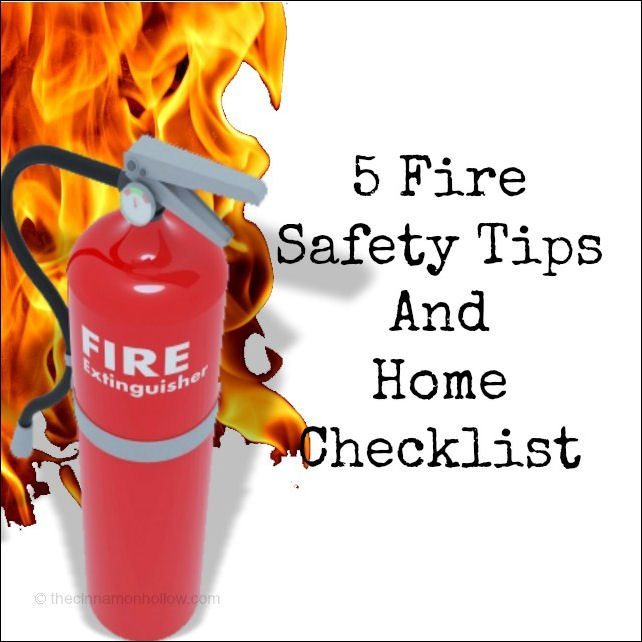Fires can break out at any moment so being prepared with a Fire Safety Plan and Checklist is something we all should do. Keeping our families safe and secure if a disaster strikes is the one thing that should be at the top of any parent’s list. Every family needs to have an escape plan in case of fire. Kids need to know what to do and where to go, so practice fitting the children gas mask, staying low, and following the planned exit route. There are a couple of things you can do to ensure that you are alerted and know how to react if a fire occurs in your home. I’ve made a little list below with 5 fire safety tips and checklist for creating your own Fire Safety Plan or Fire Escape Plan.

1.) Install smoke alarms and check batteries or wiring regularly.
Install smoke alarms on every level of your home. We have them in every room! If you have battery enabled smoke alarms and you begin to hear a constant chirping sound that sounds like a cricket, your batteries are low and need to be replaced. It’s a great idea to test your alarms with the built in test button each month and one rule of thumb for changing the battery in your smoke alarm is to go with your local time change. If your area adheres to Daylight Savings Time and the whole Spring forward / Fall back deal, then this is a great time to change smoke alarm batteries or do a test to endure your wired in alarms are functioning properly. If you don’t have a twice yearly time change, then set a time like the first day of Spring and the first day of Fall.
2.) Designate Safe Zones
Designating a safe zone like a neighbors house or the end of the driveway is a great way to keep family members together and make sure everyone is where they are supposed to be if a disaster strikes. Make sure your it is outside and as far away from the house as possible. Talk to your chosen neighbor and let them know that your family will come to them for shelter and aid in the event of an emergency. Practice with them as well. Make sure your children know to never, ever, ever go back inside for any reason!
3.) Keep Fire Extinguishers Handy
Fire extinguishers should always be kept near the kitchen for extinguishing small kitchen fires. But what about the rest of the house? The first rule of thumb to teach your children is to never “play hero”. Make sure they know to never try to put the fire out themselves. If your home is on fire they need to focus on getting out and getting somewhere safe. But if their only way out is being blocked by fire, they may not be able to get through and there might not be an alternate escape route. You should never ever try to open a door that feels warm to the touch. In that case, you’d have to remain in the room and try to stick towels or clothing under the door to prevent smoke from entering. So, in my personal opinion, keeping even small fire extinguishers in every room is a good idea in case the fire makes it into a blocked room or in case a very small fire breaks that you could extinguish, out like on the stove. There are rules and regulations for using fire extinguishers so make sure you read and follow them. Remember, they are not toys and fire is extremely dangerous so you’ll want to know how to properly use one. See your local fire department for fire extinguisher training.
4.) Teach Stop – Drop And Roll.
If your clothing is on fire, son’t run! Instead, Stop – Drop And Roll on the ground to put the fire out. Practice with your kids to help them know what to do. Teach them to not panic but to get low on the ground in case of fire and if their clothing is ignited to stop, drop and roll on the ground.
5.) Practice calling 9-1-1 and your escape plan
Teach your children how to call 9-1-1 in case of emergency. Go over what a basic call would entail and have them practice with you what they would say and how to remain calm. Make sure your children know their full name, your full name and address as well as their home phone number. Practice your escape plan at least once per season, preferably each month. Go over each aspect of your plan. If you move, make a new one and practice it regularly. Sounding your alarm in the night to test your family is another good idea. You don’t know if, when or what time a fire would break out so make sure everyone is prepared!
There are a lot more tips for fire safety and you can find many on sites like redcross.org but these are the basics that our family practices to ensure we know what to in case of fire.
I’ve created a little checklist that you can print and laminate. Hang it on your refrigerator and go over it once per month so your family knows what to do in case of fire.
[wpdm_file id=133 desc=”true” template=”bluebox drop-shadow raised” ]
Image courtesy of freedigitalphotos.net
We are not doctors and this is in no way intended to be used as medical advice and we cannot be held responsible for your results. As with any product, service or supplement, use at your own risk. Always do your own research before using.
Travel Lover | Pet Mama | Beauty Junkie | Low Glycemic – Healthy Fats – Low Carb – Keto Inspired Food Enthusiast | Cocktails | Printables
I am a stay-at-home- mom, living in KY with my husband and children. I’m a travel and lifestyle blogger encouraging folks to live their life one adventure at a time while also focusing on beauty, essential oils and health. From time to time I also like to showcase my adorable pets along with my family. Along with Cinnamon Hollow I can be found at The Martin Family Adventure … read more





